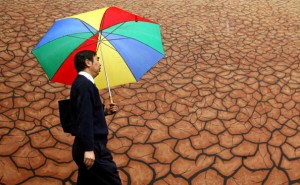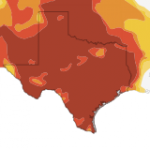Exploring the Gap Between Water Supply and Energy Development

Photo by WILLIAM WEST/AFP/Getty Images
A man shelters from the rain under his umbrella as he passes a giant mural showing the drought-affected Australian outback in 2007.
A growing shortage of freshwater is transforming into a commonplace global experience. Australia, Northern Africa, the Middle East, India, North East China, Argentina, portions of Brazil, and even Southern Europe are witnessing declines in freshwater availability.
In the U.S., states that don’t normally experience drought conditions such as Wisconsin, Illinois, Indiana and Washington are now watching water caches run dry. “Drought is a trend, rather than just a temporary event,” says Michael Hightower, a representative of Sandia National Laboratories, “We are in about a three hundred-year drought that has been ongoing since the mid-1700s.” Hightower spoke about the challenges and opportunities for the expansion of water availability at the 2012 Water Summit hosted by the University of Texas at Austin’s Academy of of Medicine, Engineering and Science.
“I don’t think our political systems are set up to handle drought,” says Hightower. He cites the growing connections between energy development and water availability as a key justification for water resource expansion. He says that water availability issues are already impacting new energy development, like with fracking (a single hydraulic fracturing well requires up to three million gallons of water) and ethanol production (which requires three to four thousand gallons of water per bushel of corn).
So, what tools do we have to decrease the growing gap between our water resources and energy development plans?
Hightower recommends better resource planning and management, improved water and energy use efficiency, and the development of alternative water resources and supplies.
Desalination efforts in the United States are increasing by ten percent per year, while water reuse is growing at fifteen percent each year. There’s no reason why Texas shouldn’t diversify its water resources as well, Hightower says.
He also notes that renewable energy systems increasingly parallel water systems. We can use solar energy or wind power to clean water supplies, for instance, Hightower says.
Behind Hightower’s comments rests an underlying hope that the drought will result in some fruitful modifications: that with continued focus, the drought might just usher in a new era of water innovation.




